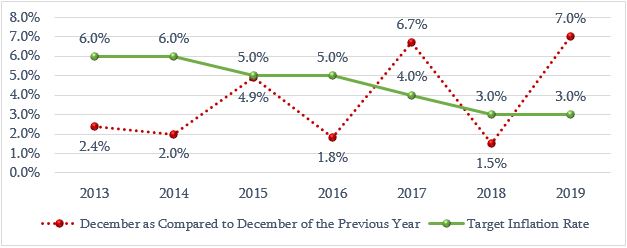Resume:
As a result of inflation, money’s purchasing power declines in time. Hypothetically, less goods and services can be purchased with GEL 1 now as compared to years ago and this argument holds true vis-à-vis any currency in the world, not only GEL. As of June 2020, the price level increased by 31% as compared to October 2012 whilst December 2019’s inflation is 29.9% higher as compared to what it was in December 2012. Therefore, as compared to 2012, GEL 1 value has decreased to GEL 0.76 and not GEL 0.5.
On the one hand, Giorgi Vashadze’s figure is substantially lower as compared to the real number and, on the other hand, he seeks to put this in a particularly negative light. To make an emphasis on the total inflation, taking several years together, might provide a dramatic impression although it is necessary to consider the annual dynamic for an analysis of the real situation. Generally, moderate inflation; that is, a price level increase, is a natural process and quite frequently goes hand in hand with economic growth. Since 2009, the National Bank of Georgia has been setting the target inflation rate. In 2013-2010, the annual inflation exceeded the target inflation only in 2017 (by 2.7%) and 2019 (by 4%). This was obviously an undesirable occurrence although we cannot say that the total inflation dynamic gives us a ground for serious concern. Currency losing its purchasing power in time is a natural consequence of the economic process and Georgia is not an exception in this regard.
Analysis
The leader of the political platform Strategy Builder, Giorgi Vashadze, at the official opening of his election campaign, stated: “They only thing this government achieved is that after their eight-year rule, GEL 1 value is now GEL 0.5.”
As a result of inflation, money’s purchasing power declines in time and less goods and services can be purchased with GEL. Consumer price inflation is measured by the Consumer Price Index which includes prices in 12 large groups of goods. These groups are as follows: 1) food and non-alcoholic beverages, 2) alcoholic beverages and tobacco, 3) garments and footwear, 4) accommodation, water, energy, gas, 5) furniture, household items, house repair, 6) healthcare, 7) transport, 8) communication, 9) vacation, leisure and culture, 10) education, 11) hotels, cafes and restaurant and 12) different goods and services.
The personal inflation calculator, a tool of the National Statistics Service of Georgia, allows us to follow the inflation-induced dynamic of GEL purchasing power. As of current June 2020 data, the inflation growth constitutes 31% as compared to October 2012 whilst the inflation growth in December 2019 is 29.9% higher as compared to December 2012. Therefore, we can conclude that GEL 1 value decreased to GEL 0.76 as compared to 2012 and not to GEL 0.5 as claimed by Mr Vashadze.
Generally, moderate inflation; that is, a price level increase, is a natural process and quite frequently goes hand in hand with economic growth. It is important that economic growth and the growth of other incomes exceed the inflation growth which eventually would lead us to real growth.
Since 2009, the National Bank of Georgia’s monetary policy has been inflation targeting. The policy envisions a prior determination of the target inflation rate which has to be kept in a mid-term period. The National Bank of Georgia sets the target inflation figure which is later approved by the Parliament of Georgia. Therefore, in order to assess inflationary processes, it is important to analyse how inflation was kept within the targeted margins.
Graph 1: Target and Real Inflation Rates in 2012-2019

Source: National Statistics Office of Georgia
The annual inflation exceeded the target inflation only in 2017 and 2019, by 2.7% and 4%, respectively. This was obviously an undesirable occurrence although we cannot say that the total inflation dynamic provided a ground for serious concern.







